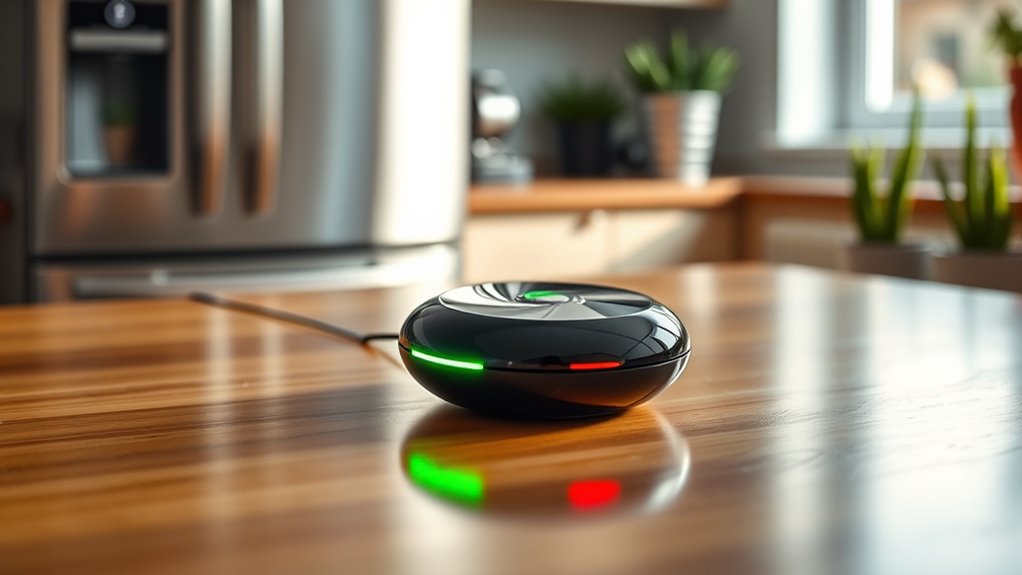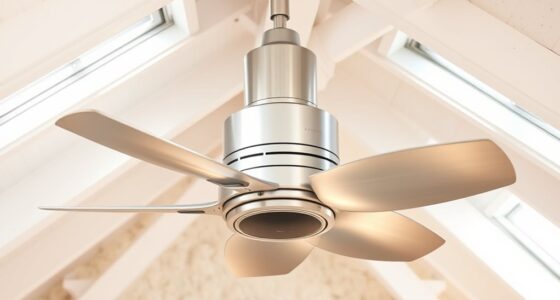If you’re looking to keep your home safe from hydrogen leaks in 2025, I recommend exploring the top 14 sensors available today. These include fixed detectors, portable units, sniffer devices, and smart sensors with high sensitivity, quick response times, and reliable alarms. Features like remote monitoring, durable construction, and easy calibration are essential. To find the best fit for your needs, maintain reading as you’ll discover the most effective options to ensure your safety effortlessly.
Key Takeaways
- Prioritize detectors with high sensitivity, fast response times, and reliable alarm systems for early leak detection.
- Opt for portable, easy-to-use sensors suitable for DIY home inspections and quick assessments.
- Choose devices with real-time digital displays, visual/audible alerts, and remote monitoring capability for comprehensive safety.
- Select sensors with durable, explosion-proof designs and water/dust resistance for long-term home use.
- Ensure compatibility with existing smart home systems and data output options for seamless integration and remote management.
DetecTape H2 Visual Hydrogen Leak Detector Tape

If you’re looking for a quick and reliable way to detect hydrogen leaks in industrial settings, the DetecTape H2 Visual Hydrogen Leak Detector Tape is an excellent choice. It instantly changes color from light gray to dark black when hydrogen is present, providing clear, visual leak detection at the source. Easy to apply with a self-fusing silicone wrap, it fits valves, joints, and connectors without training. Made from durable silicone, it withstands harsh conditions like chemicals, water, and UV exposure. No batteries are needed, and it’s compatible with infrared cameras and thermal detectors, making safety and maintenance straightforward and efficient.
Best For: industrial professionals seeking quick, reliable, and visual hydrogen leak detection in harsh environments without the need for external power sources.
Pros:
- Provides near-instant color change for immediate leak identification
- Easy to apply and remove without training, suitable for various connection points
- Durable silicone construction resists chemicals, water, UV, and harsh conditions
Cons:
- Limited to hydrogen leak detection only, not suitable for other gases
- May require replacement if leaks are persistent or for continuous monitoring
- Visual detection might be less effective in extremely dusty or obscured environments
Gas Leak Detector with 4 Gas Alarms (CO, O2, H2S, LEL)
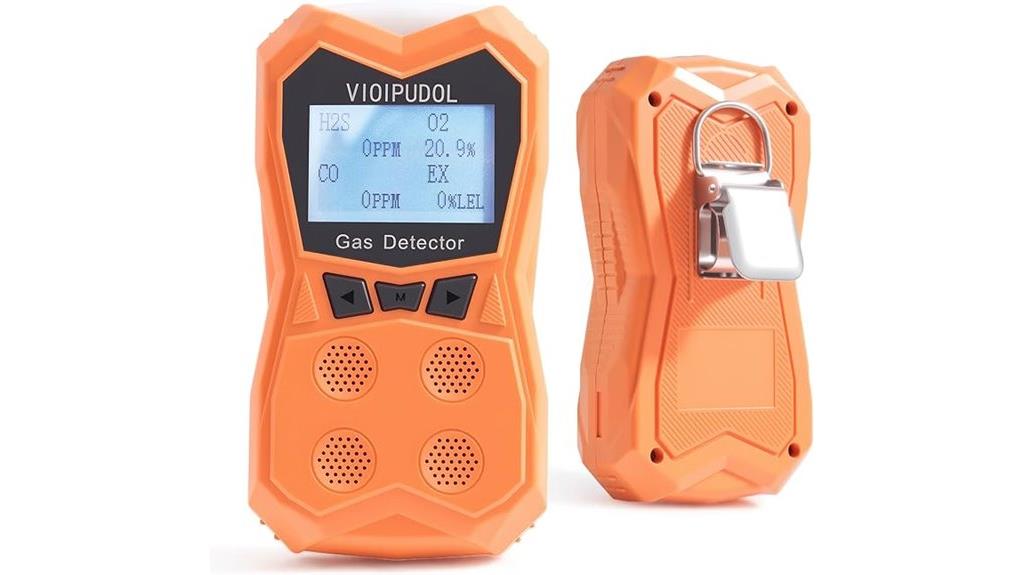
The Gas Leak Detector with 4 Gas Alarms (CO, O2, H2S, LEL) is an excellent choice for professionals who need rapid, reliable detection of multiple gas hazards in challenging environments. It detects H2S, CO, LEL, and O2 gases in under 0.5 seconds, thanks to high-stability sensors imported from the UK. Its waterproof, dustproof, and explosion-proof design ensures durability in tough conditions. With a battery life of up to 16 hours, it supports continuous monitoring. The device features triple alarms—LED, vibration, and sound—and records events for easy review, making it an all-encompassing safety tool for industrial or hazardous settings.
Best For: professionals in industrial, construction, or hazardous environments needing rapid and reliable multi-gas detection for safety management.
Pros:
- Rapid detection of H2S, CO, LEL, and O2 gases in under 0.5 seconds for quick response.
- Durable, waterproof, dustproof, and explosion-proof design suitable for tough environments.
- Long battery life of up to 16 hours with continuous monitoring and event recording features.
Cons:
- Initial setup requires password protection, which may be cumbersome for some users.
- The device’s size and weight might be less convenient for prolonged handheld use.
- Requires regular calibration and maintenance to ensure sensor accuracy over time.
ATO Portable Hydrogen Gas Detector (0-1000 ppm) with LCD Display
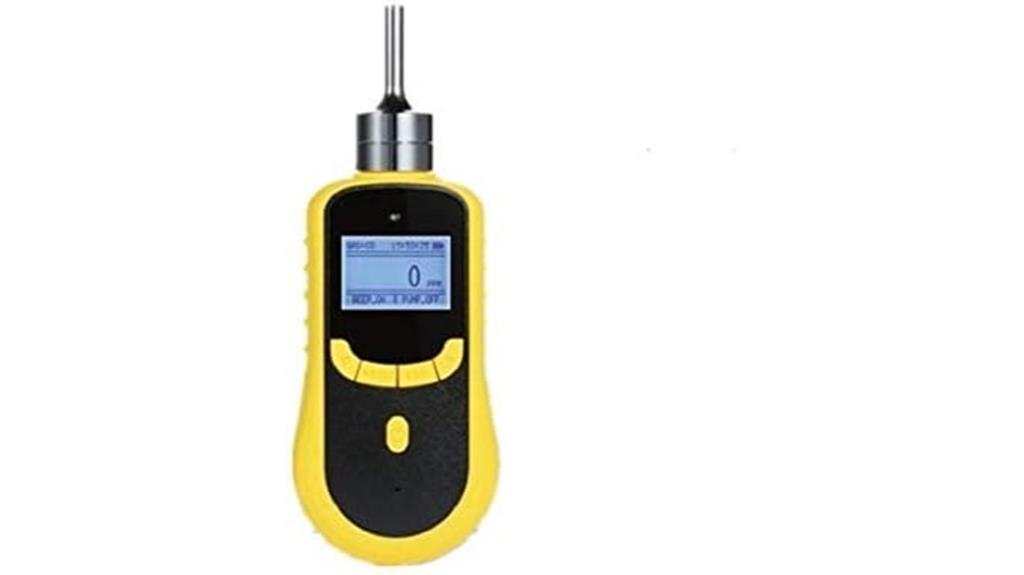
For professionals needing reliable hydrogen detection in demanding environments, the ATO Portable Hydrogen Gas Detector stands out with its LCD dot matrix display that provides instant, clear readings of gas concentration, type, and environmental data. It measures 0-1000 ppm with 1 ppm resolution and supports quick switching between English and Chinese. Its built-in micro-sampling pump offers 10 suction grades, ensuring accurate sampling. Certified explosion-proof and built with durable, waterproof, dustproof housing, it’s suitable for harsh conditions. The device features self-calibration, zero calibration, temperature and pressure compensation, and adjustable alarms, making it a dependable tool for safety and precise detection.
Best For: Professionals and safety personnel requiring reliable, portable hydrogen detection in demanding industrial, laboratory, or field environments.
Pros:
- Accurate measurement with 1 ppm resolution up to 1000 ppm, ensuring precise detection.
- Durable, explosion-proof, waterproof, and dustproof housing suitable for harsh conditions.
- Supports quick unit switching and environmental compensation for reliable readings in varying conditions.
Cons:
- May be more expensive than basic hydrogen detectors due to advanced features and certifications.
- Requires regular calibration and maintenance to ensure optimal performance.
- Limited to hydrogen detection; not suitable for multi-gas detection without additional sensors.
Hydrogen Gas Detector for Battery Room Monitoring
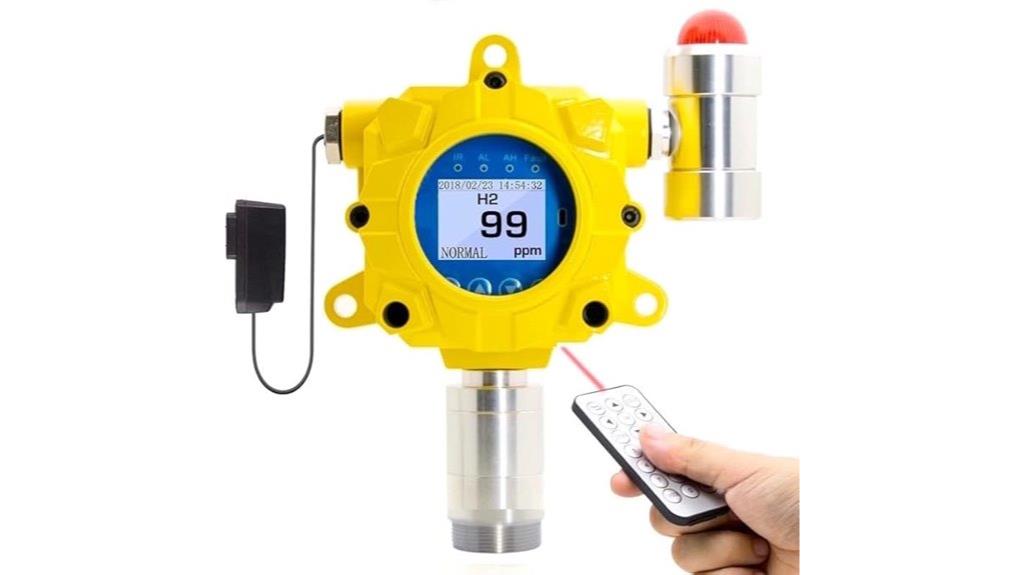
A hydrogen gas detector designed specifically for battery room monitoring offers a reliable solution for detecting hydrogen leaks in environments where safety is critical. This heavy-duty, industrial-grade device can detect hydrogen concentrations from 0 to 1000 ppm, ensuring continuous, accurate monitoring. Calibrated with NIST traceability in Los Angeles, it comes with calibration and QA certificates for verified performance. Equipped with large LED indicators, adjustable buzzer alarms, and remote control features up to 8 meters, it allows for flexible operation. Its rugged construction, explosion-proof grade, and waterproof housing make it suitable for harsh conditions, providing peace of mind in safeguarding battery rooms.
Best For: facilities and safety managers needing reliable hydrogen leak detection in battery rooms or industrial environments requiring continuous monitoring.
Pros:
- Provides accurate detection of hydrogen concentrations up to 1000 ppm with NIST traceable calibration.
- Features customizable alarm systems with visual LED indicators and adjustable buzzer alerts.
- Built with rugged, explosion-proof and waterproof housing suitable for harsh industrial conditions.
Cons:
- May require professional installation and calibration for optimal performance.
- The remote control range is limited to 8 meters, which might not suit larger facilities.
- The device’s complexity could necessitate training for proper operation and integration into existing safety systems.
Hydrogen Gas Detector 0-1000 PPM with Alarm and Rechargeable Monitor
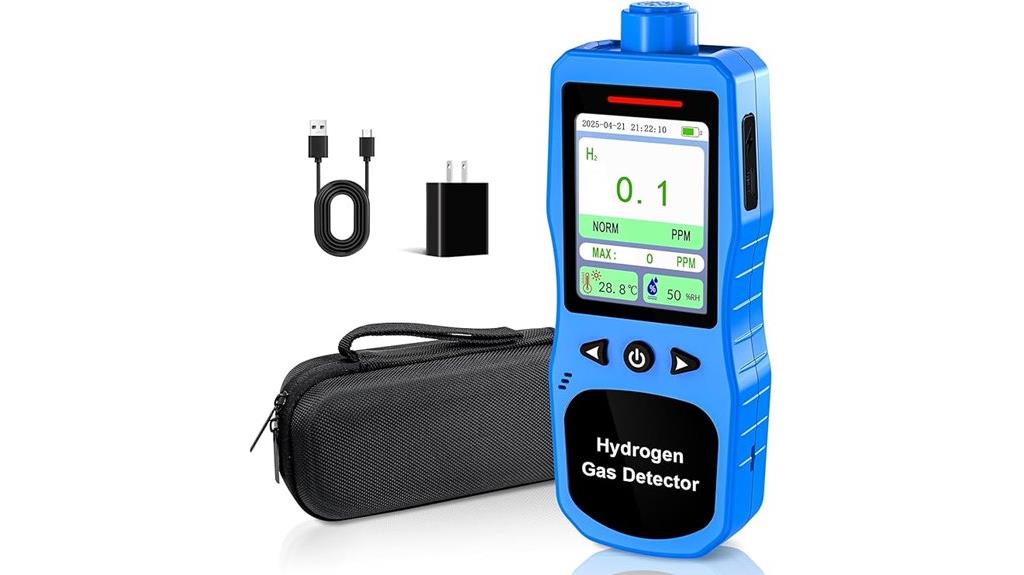
If you’re seeking a reliable hydrogen leak detector that offers real-time monitoring and customizable alerts, the Hydrogen Gas Detector ZY-HD4000-Blue stands out. It measures hydrogen concentrations from 0-1000 ppm with a quick 0.5-second response, providing instant alerts through visual, audible, and vibration alarms. Its rechargeable battery, data logging, and portable design make it perfect for industrial, lab, or home use. The device also tracks temperature and humidity, ensuring all-encompassing safety. Built from explosion-proof ABS, it’s sturdy and easy to carry, with adjustable brightness and auto/manual power-off features to enhance convenience and security.
Best For: industrial, laboratory, and home users seeking reliable, real-time hydrogen leak detection with customizable alerts and portability.
Pros:
- Rapid 0.5-second response time for instant leak detection
- Multiple alert modes including visual, audible, and vibration alarms for enhanced safety
- Rechargeable design with data logging and adjustable brightness for convenience and comprehensive monitoring
Cons:
- Does not include batteries; requires separate purchase
- Not suitable for testing hydrogen water applications
- Limited to detecting hydrogen concentrations up to 1000 ppm, which may not cover all specialized needs
Hydrogen Gas Analyzer by Forensics
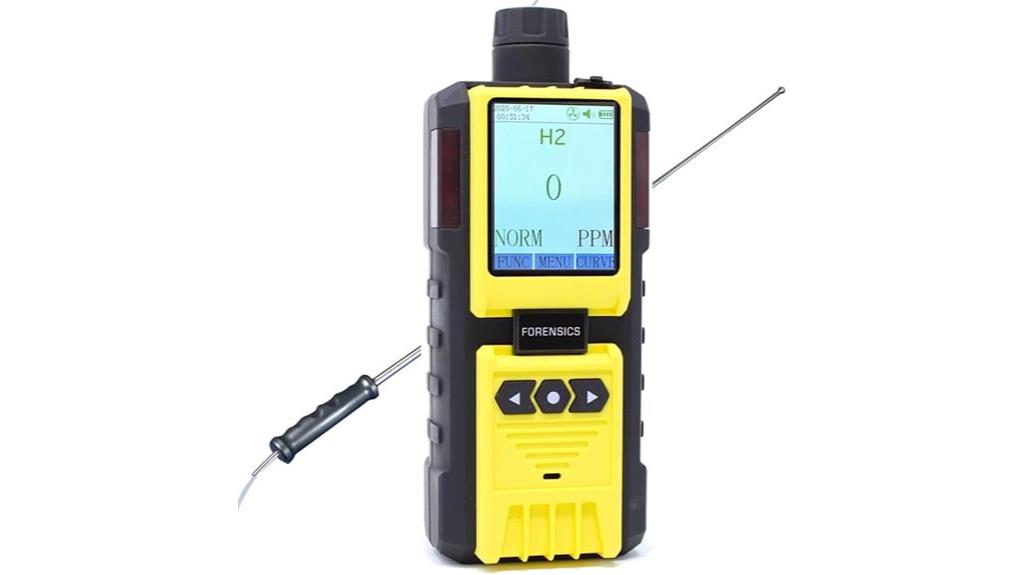
The Hydrogen Gas Analyzer by Forensics stands out with its NIST calibration and precise measurement capabilities, making it ideal for professionals who need reliable readings of hydrogen concentrations. It measures from 0 to 1000 ppm with a 1 ppm resolution, ensuring accurate detection of small leaks. The device features a built-in pump and a 4-foot probe for quick, efficient detection. Its color display, graph functions, and data logging make monitoring straightforward. Designed to withstand tough conditions, it’s shockproof, water-resistant, dustproof, and explosion-proof. With alarms, a belt clip, USB charging, and a 1-year warranty, it combines durability, portability, and high performance for safety assurance.
Best For: professionals in industrial, safety, or forensic settings requiring accurate, reliable hydrogen leak detection and monitoring.
Pros:
- NIST calibration ensures highly accurate measurements for safety and compliance
- Built-in pump and 4ft probe enable rapid and efficient detection of hydrogen leaks
- Durable, shockproof, water-resistant, dustproof, and explosion-proof design suitable for tough environments
Cons:
- May be more expensive compared to basic hydrogen detectors
- Requires regular calibration and maintenance to maintain accuracy
- The device’s advanced features and size may be less suitable for casual or occasional use
DetecTape® H2 Hydrogen Leak Detector Tape
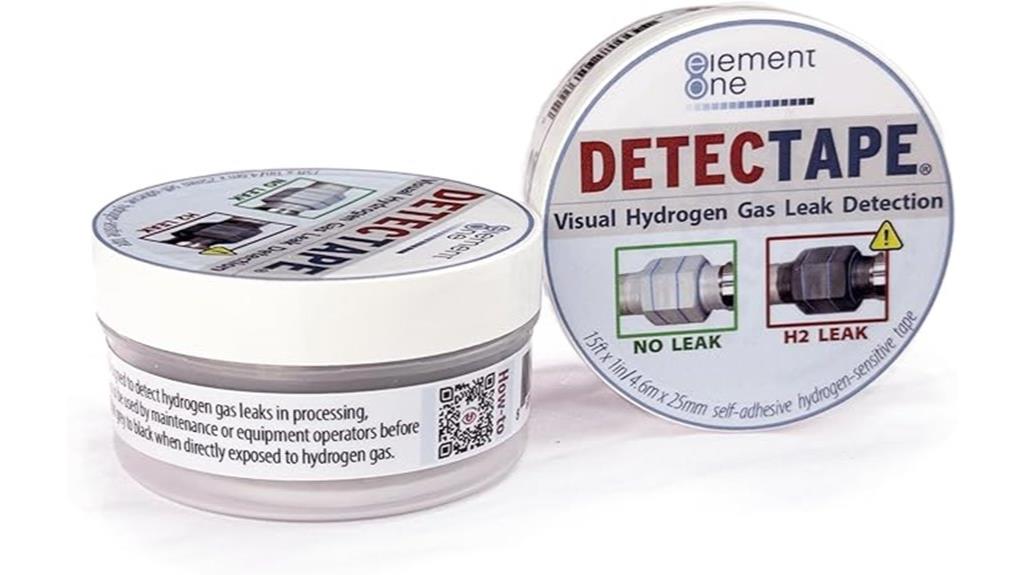
DetecTape® H2 Hydrogen Leak Detector Tape stands out for industrial environments where quick, visual leak detection is essential. It instantly changes from light gray to dark black when hydrogen is present, making leak identification straightforward. Easy to apply with a self-fusing silicone wrap, it works on valves, joints, flanges, and connectors without needing training. Made from durable silicone, it withstands harsh conditions like chemicals, water, and UV exposure. Its compact size and compatibility with infrared cameras, sniffers, and thermal devices make it versatile. Best of all, it’s battery-free, providing reliable, immediate visual alerts that enhance safety and operational efficiency.
Best For: industrial safety professionals and maintenance teams needing quick, reliable hydrogen leak detection in demanding environments.
Pros:
- Provides instant visual indication of hydrogen leaks by changing color from light gray to black.
- Easy to apply and remove with a self-fusing silicone wrap, requiring no training.
- Durable and resistant to chemicals, water, and UV exposure, suitable for harsh conditions.
Cons:
- Limited to visual detection; cannot quantify leak size or concentration.
- May need to be replaced frequently in highly dynamic or extremely corrosive environments.
- Compatibility with only certain detection devices, requiring additional tools for comprehensive analysis.
Robinair LD9-TG Tracer Gas Leak Detector
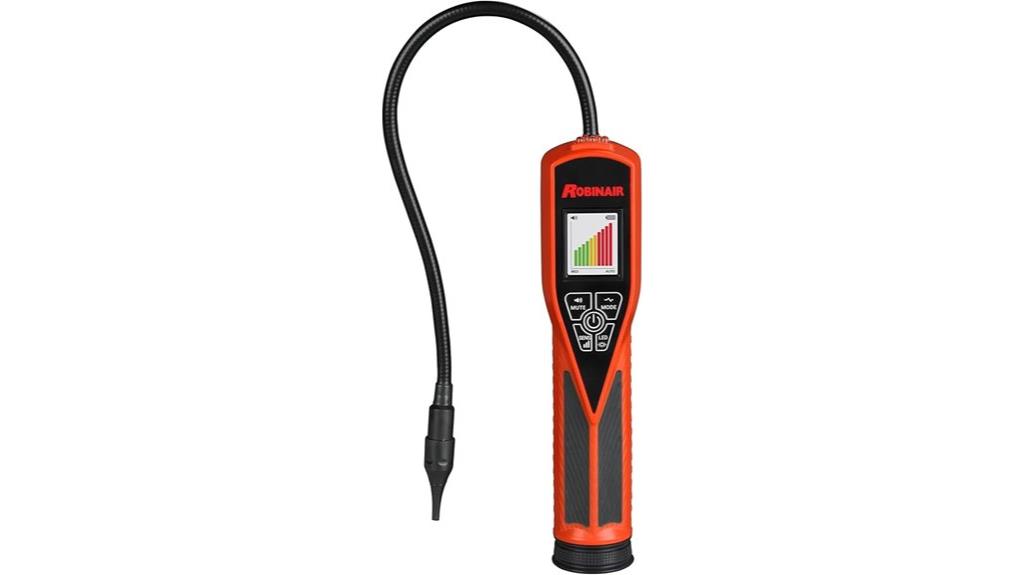
For technicians seeking quick and precise leak detection, the Robinair LD9-TG Tracer Gas Leak Detector stands out with its instant response time and high sensitivity. It uses UV wavelength technology to detect leaks with a 5% hydrogen and 95% nitrogen tracer gas mixture, avoiding the need for liquid refrigerant. The device can identify tiny leaks as small as 0.05 ounces per year for R-134a, and it features a durable sensor with a 10-year lifespan. The full-color LCD, inspection light, and 17-inch probe make locating hard-to-reach leaks straightforward, while its fast warm-up and battery life keep your workflow efficient.
Best For: HVAC technicians and automotive service professionals seeking fast, accurate leak detection with minimal setup.
Pros:
- Instant response time for quick leak pinpointing
- High sensitivity capable of detecting tiny leaks as small as 0.05 ounces per year
- Durable 10-year sensor lifespan and full-color LCD display for ease of use
Cons:
- Requires 4 AA batteries, which may need frequent replacement during heavy use
- Limited to detecting leaks with hydrogen/nitrogen tracer gas, not liquid refrigerants
- Probe length of 17 inches may be restrictive in very tight or awkward spaces
RIDGID Micro Combustible Gas Diagnostic Detector

If you’re searching for a reliable gas detector that can handle a variety of combustible gases, the RIDGID Micro Combustible Gas Diagnostic Detector stands out as an excellent choice. It detects methane, propane, butane, ethanol, ammonia, and hydrogen quickly and accurately. Its flexible 16-inch probe allows for easy access to tight spaces, while Tri-Mode alerts—visual, audible, and vibration—ensure you’re always aware of leaks. With adjustable sensitivity, it can identify low gas levels within seconds. Built tough and ergonomically designed, it’s perfect for both professional and home use, providing reliable, real-time gas detection to keep your environment safe.
Best For: professionals and homeowners needing quick, accurate detection of various combustible gases in tight or hard-to-reach spaces.
Pros:
- Detects a wide range of gases including methane, propane, butane, ethanol, ammonia, and hydrogen with precision.
- Flexible 16-inch probe and Tri-Mode alerts (visual, audible, vibration) enhance usability in confined environments.
- Adjustable sensitivity settings allow for rapid identification of low-level gas leaks.
Cons:
- May require regular sensor replacement to maintain optimal performance.
- As a handheld device, it might be less suitable for continuous or industrial-scale monitoring.
- The device’s effectiveness depends on proper calibration and maintenance.
H2S Monitor Clip, Portable Hydrogen Sulfide Gas Detector
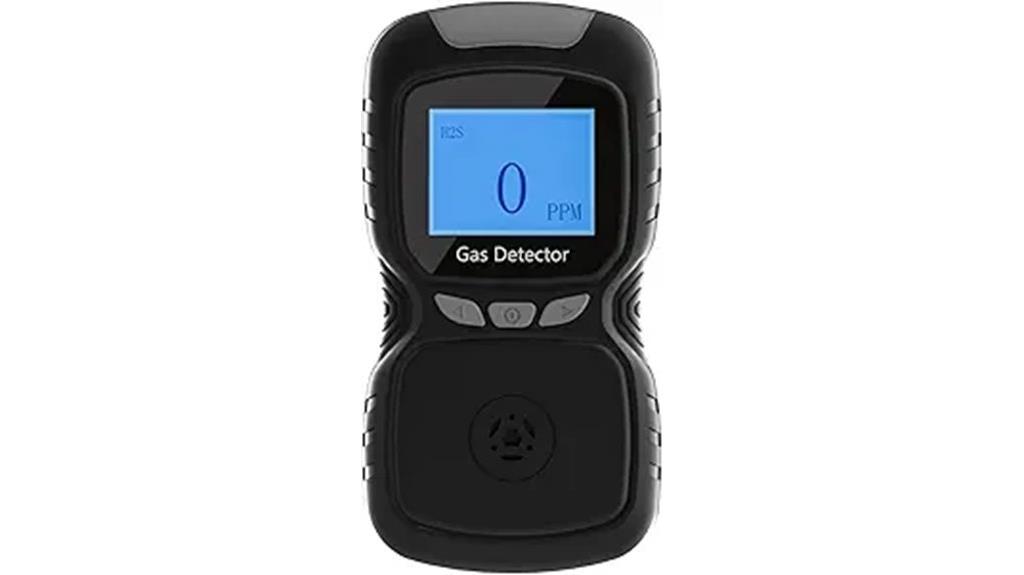
The H2S Monitor Clip stands out for its portability and quick response, making it ideal for workers in confined or underground spaces where safety is critical. It detects hydrogen sulfide levels from 0 to 100 ppm and alerts within 30 seconds through voice, a loud alarm, vibration, and LED indicators. Its LCD display provides clear readings, while the durable ABS and rubber casing ensures shock, dust, waterproof, and explosion resistance. Powered by a high-capacity battery, it’s designed for long shifts. With its clip, you can keep it hands-free, making it a reliable, lightweight tool for monitoring H2S in hazardous environments.
Best For: workers in confined, underground, or hazardous environments needing quick and reliable H2S detection for safety monitoring.
Pros:
- Rapid response within 30 seconds with multiple alert methods (voice, alarm, vibration, LED)
- Durable, shock-resistant, waterproof, and explosion-proof casing suitable for tough environments
- Portable and lightweight with a clip for hands-free operation and real-time LCD readings
Cons:
- Detection threshold is set at 60 ppm, which may delay alerting in environments with H2S levels below this point
- Limited to single-gas detection, so not suitable if multiple gases need to be monitored simultaneously
- Factory calibration and alarm thresholds may require adjustment for specific environmental conditions
Fixed Single H2 Leak Detector Alarm with RS485 Signal Output
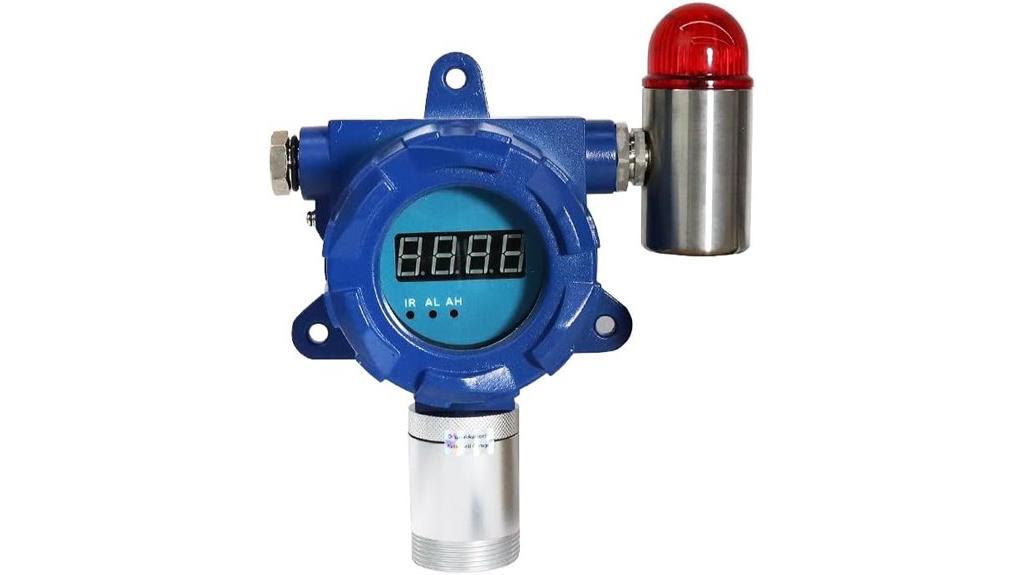
A fixed single H2 leak detector alarm with RS485 signal output stands out for its ability to provide precise, real-time hydrogen concentration data in industrial settings. It’s designed to detect hydrogen leaks in confined spaces like basements, car parks, and sewers, with an advanced sensor and explosion-proof construction. The device offers customizable alarm points and supports remote control, enabling continuous online monitoring. Its RS485 output ensures accurate data transmission to control systems, making it ideal for industrial safety management. Affordable and reliable, this detector helps prevent accidents by alerting you immediately to hydrogen leaks, ensuring safe operation in various environments.
Best For: industrial safety managers and facility operators needing reliable, real-time hydrogen leak detection with remote monitoring capabilities.
Pros:
- Provides precise hydrogen concentration data with customizable alarm points
- Supports remote control and continuous online monitoring for enhanced safety management
- Features explosion-proof design and advanced sensors for reliable detection in hazardous environments
Cons:
- May require professional setup for optimal integration with existing control systems
- Higher initial cost compared to simpler hydrogen detectors
- Limited to fixed installations, less portable for mobile inspection needs
ATO Fixed Hydrogen Sulfide (H2S) Gas Detector

For those seeking reliable hydrogen sulfide detection in industrial settings, the ATO Fixed H2S Gas Detector stands out with its high-precision electrochemical sensors and adjustable alarm thresholds. It detects H2S levels from 0-100 ppm accurately, with a two-stage alarm system featuring sound and light indicators. Its explosion-proof design guarantees safety, while remote monitoring is possible via 4-20mA and RS485 outputs. The device supports self-calibration, on-site maintenance, and integration with control systems like PLC and DCS. With easy operation, high durability, and customizable safety responses, it provides dependable protection against gas leaks in demanding environments.
Best For: industrial facilities requiring reliable, high-precision hydrogen sulfide detection with integrated safety and remote monitoring capabilities.
Pros:
- High-precision electrochemical sensors ensure accurate H2S detection within 0-100 ppm range.
- Explosion-proof design guarantees safety in hazardous environments.
- Supports remote monitoring and control via 4-20mA, RS485 interfaces, and integration with PLC/DCS systems.
Cons:
- Requires corded power source, limiting portability.
- May involve complex setup for advanced control system integration.
- Maintenance and calibration might necessitate trained personnel for optimal performance.
GD700-H2 Fixed Gas Leak Detector Sniffer (0-2000ppm, Wall Mounted, Sound & Light Alarm)
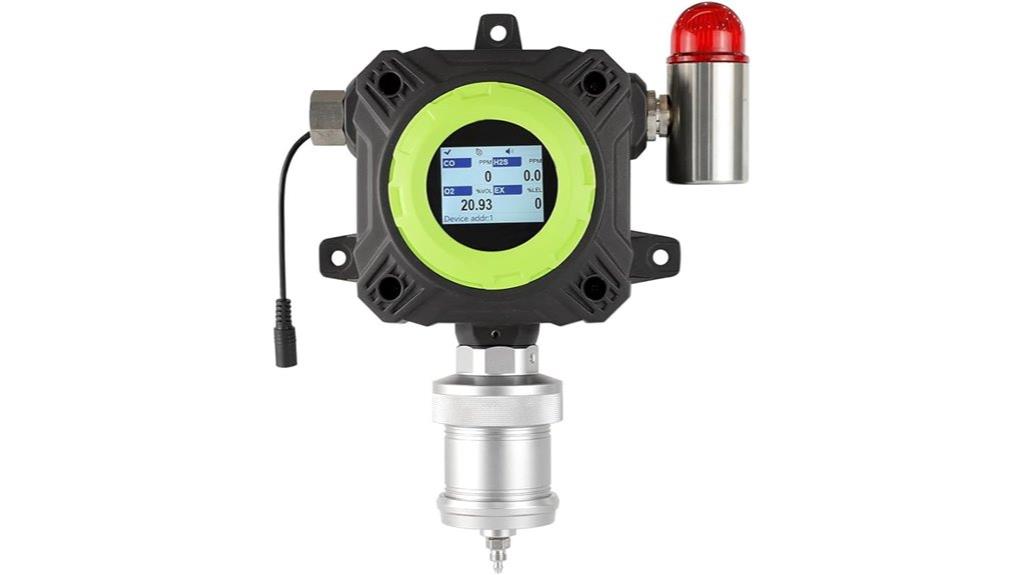
If you need a reliable solution for continuous hydrogen leak monitoring, the GD700-H2 Fixed Gas Leak Detector Sniffer stands out with its wall-mounted design and real-time digital display. It detects hydrogen concentrations from 0 to 2000ppm and features sound and light alarms to alert you immediately of leaks. The device supports remote control via infrared, making adjustments easy from a distance. Designed for industrial environments, it offers automatic calibration and an explosion-proof build for safety. With multiple alarm levels and remote data output, it ensures your home or facility stays protected around the clock. It’s a dependable choice for ongoing hydrogen safety.
Best For: industrial facilities and safety professionals seeking reliable, continuous hydrogen leak monitoring with real-time alerts and remote control capabilities.
Pros:
- Supports multiple detection ranges with high accuracy for hydrogen leaks.
- Features automatic and zero calibration, ensuring consistent performance over time.
- Explosion-proof design and 24-hour online monitoring enhance safety in hazardous environments.
Cons:
- Requires corded power supply, limiting placement flexibility.
- May involve a learning curve for remote control and alarm setting adjustments.
- Higher cost compared to simpler, portable leak detectors due to advanced features and industrial build.
Hydrogen Leak Detector
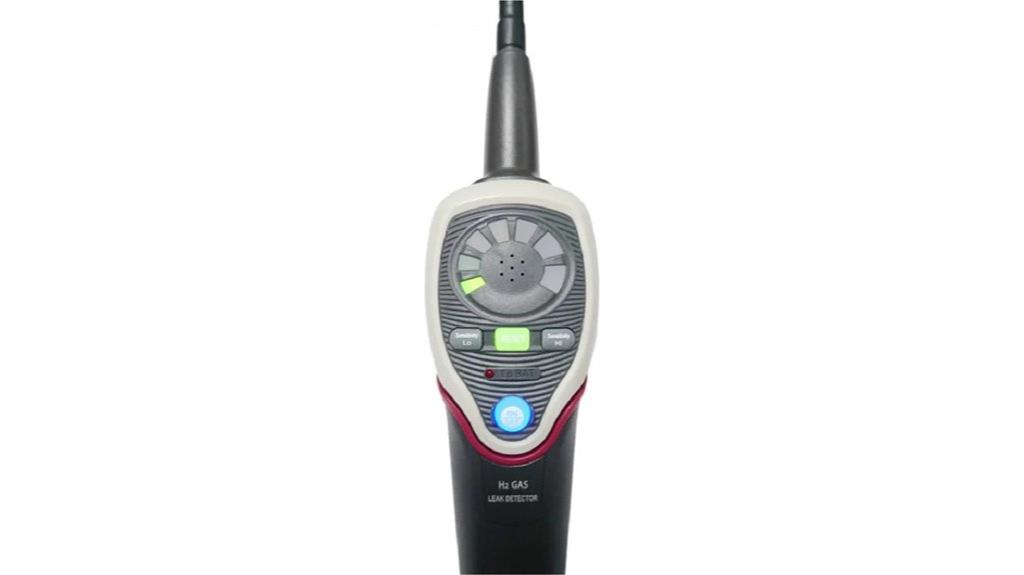
The Hydrogen Leak Detector Model CENTER-384 stands out as an ideal choice for professionals and DIY enthusiasts seeking reliable detection of hydrogen leaks. Manufactured by QATNYLKDA, it detects combustible gases at sensitivities below 5 ppm, specifically a mix of 5% hydrogen and 95% other gases. It features an LCD screen, buzzer alarm, and LED bar indicator to provide real-time alerts. Weighing just 1.76 ounces and measuring 0.39 inches in each dimension, it’s compact and easy to handle. Powered via an external source, it’s perfect for safety monitoring in environments where hydrogen leaks could be critical, ensuring peace of mind and home safety.
Best For: DIY enthusiasts and professionals needing reliable, real-time hydrogen leak detection in safety-critical environments.
Pros:
- Sensitive detection capability below 5 ppm for accurate leak identification
- Compact, lightweight design (1.76 ounces, 0.39 inches in each dimension) for easy handling and placement
- Equipped with LCD display, buzzer alarm, and LED indicators for immediate alerts
Cons:
- No batteries included; requires an external power source for operation
- Limited to detecting a specific gas mixture of 5% hydrogen and 95% other gases
- Availability begins from August 14, 2025, which may not suit urgent needs immediately
Factors to Consider When Choosing a Hydrogen Leak Detector Sensor
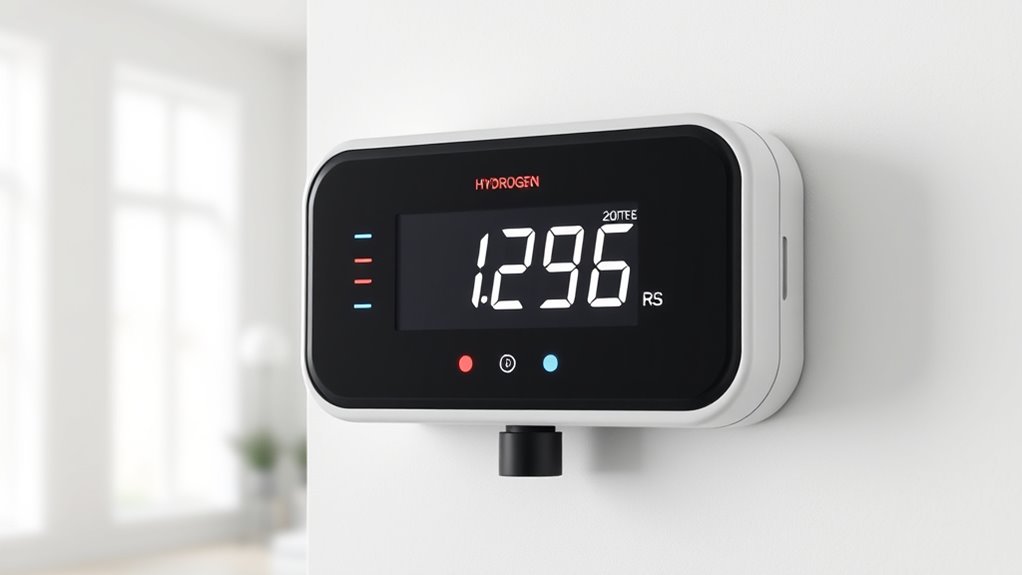
When choosing a hydrogen leak detector sensor, I consider factors like detection sensitivity, response time, and how well it can withstand different environments. I also look at power options and how the device alerts me to leaks, whether through alarms or notifications. These points help guarantee I pick a sensor that’s reliable and suited to my specific needs.
Detection Sensitivity Levels
Detection sensitivity levels play a indispensable role in choosing the right hydrogen leak detector sensor because they determine how small a leak can be reliably identified. Sensors with higher sensitivity can detect lower ppm levels, allowing for earlier warnings before leaks become dangerous. The sensitivity range varies widely, from as low as 1 ppm to several thousand ppm, depending on the sensor’s technology and application. Accurate calibration is essential to prevent false alarms caused by environmental factors or minor fluctuations. Selecting a sensor with appropriate sensitivity ensures a balanced response—detecting leaks promptly without overreacting to harmless variations. This balance helps protect your home effectively, providing peace of mind while avoiding unnecessary disruptions or missed hazards.
Response Time Speed
Choosing a hydrogen leak detector sensor with a quick response time is essential because it guarantees that leaks are identified immediately, reducing the risk of hazards. A faster response means the alarm activates swiftly, allowing me to take quick mitigation steps before hydrogen levels become dangerous. Ideally, response times under one second are best for high-risk environments, ensuring leaks are detected before reaching hazardous concentrations. The response time is measured from gas exposure to alarm activation, so shorter times reflect higher sensitivity and efficiency. However, I need to balance speed with sensor stability to avoid false alarms that could cause unnecessary shutdowns. A reliable detector with rapid response helps me maintain safety and peace of mind, especially in critical settings.
Environmental Durability
Environmental durability is crucial because a hydrogen leak detector must perform reliably in harsh conditions. I recommend choosing sensors with high chemical resistance to withstand exposure to water, UV radiation, and chemicals, guaranteeing they last longer. Make sure the sensor’s temperature tolerance matches your environment, with ratings of at least 450°F for industrial settings. Rugged, explosion-proof enclosures, like Exd ⅡC T6 Gb, help maintain safety and durability in hazardous environments. It’s also essential to select sensors with dustproof, waterproof, and shock-resistant features to prevent damage from physical impacts or environmental factors. Finally, verify that the sensor’s calibration stability and resistance to environmental contaminants support consistent, reliable leak detection over time. These considerations ensure your sensor remains effective and safe long-term.
Power Supply Options
Selecting the right power supply for a hydrogen leak detector sensor is essential because it directly impacts the device’s reliability, deployment, and maintenance. Battery-powered sensors offer portability and flexibility, making them ideal for locations where wiring isn’t feasible, but they require regular charging or replacement to ensure continuous operation. Sensors with external power supplies provide stability and are better suited for fixed installations, offering long-term, dependable performance. Rechargeable sensors strike a balance, combining portability with reusability, often using USB or standard chargers for convenience. Your choice depends on your specific environment, whether you need mobility or consistent power. Ultimately, the power supply option influences how easily you can maintain, deploy, and trust your hydrogen leak detector’s performance over time.
Alarm Notification Methods
Alarm notification methods are critical for ensuring timely responses to hydrogen leaks, as they directly affect how quickly personnel can become aware of a potential hazard. Visual indicators, like LED alerts or display messages, provide immediate confirmation at the detection site, enabling quick local action. Audible alarms, often between 85-120 decibels, are essential in noisy environments or when immediate attention is needed, ensuring everyone nearby is alerted. Vibration alerts serve as discreet notifications, useful when loud sounds aren’t suitable. Remote signaling methods, including wireless alerts, 4-20mA outputs, or RS485 signals, allow centralized monitoring and automated responses, enhancing safety in complex systems. Choosing the right notification method depends on the environment and the urgency required for effective leak detection.
Compatibility With Systems
When choosing a hydrogen leak detector sensor, verifying its compatibility with your existing control and monitoring systems is a key step. I recommend checking if the sensor integrates smoothly with your setup, whether it’s PLCs, DCS, or remote alarm units. Look for standard communication interfaces like RS485, 4-20mA, or digital outputs, which facilitate easy integration. It’s crucial to confirm that the sensor’s output signals match your system’s input requirements for accurate data transmission and alarms. Additionally, consider whether the sensor supports remote control, data logging, or compatibility with building management systems, especially if you want extensive oversight. Ensuring these aspects align will make system integration seamless and help maintain reliable, real-time hydrogen leak detection.
Calibration and Maintenance
Regular calibration and diligent maintenance are essential to guarantee your hydrogen leak detector sensor remains accurate and reliable over time. I recommend calibrating the sensor at least every 6 to 12 months using certified gas standards to ensure precise detection. Calibration involves exposing the sensor to a known hydrogen concentration, allowing you to verify and adjust its readings as needed. Maintenance also means inspecting for physical damage, cleaning sensor surfaces, and checking that all electronic connections are secure. Replacing sensors when indicated by manufacturer guidelines or signs of drift helps maintain accuracy. Staying on top of these tasks ensures your detector functions correctly, providing peace of mind and safeguarding your home against potential hydrogen leaks.
Frequently Asked Questions
How Often Should Hydrogen Leak Detector Sensors Be Calibrated?
I recommend calibrating hydrogen leak detector sensors at least once a year to guarantee they stay accurate and reliable. If you notice any false alarms or inconsistent readings, it’s wise to calibrate more frequently. Regular calibration helps maintain safety, especially in homes or workplaces where hydrogen use is common. Always follow the manufacturer’s instructions for calibration intervals and procedures to keep your sensor functioning properly.
Can Detectors Differentiate Between Hydrogen and Other Gases?
Absolutely, detectors can tell the difference! Modern sensors are like superheroes with specialized powers, identifying hydrogen among a crowd of gases with astonishing precision. They use advanced technology to detect specific molecules, ensuring false alarms from other gases are nearly impossible. So, when it comes to safety, you can trust these high-tech marvels to distinguish hydrogen from everything else, keeping your home safe and sound.
What Is the Typical Lifespan of Hydrogen Leak Sensors?
Hydrogen leak sensors typically last around 2 to 5 years, depending on the quality and usage. I recommend checking the manufacturer’s guidelines for precise lifespan details. Regular maintenance, such as cleaning and testing, can extend their effectiveness. I always stay vigilant and replace sensors as recommended to guarantee my home stays safe from hydrogen leaks. Proper maintenance helps keep detection reliable and prevents any potential hazards.
Are There Wireless Hydrogen Leak Detectors Available?
Think of wireless hydrogen leak detectors as the silent sentinels of your home’s safety network. Yes, they’re available and offer the convenience of remote alerts, eliminating the need for constant manual checks. I’ve seen them connect seamlessly to your smartphone, giving you real-time updates no matter where you are. This technology guarantees peace of mind, making your home smarter and safer without the hassle of tangled wires or manual monitoring.
How Do Environmental Conditions Affect Detector Accuracy?
Environmental conditions definitely impact detector accuracy. I’ve noticed that high humidity or temperature fluctuations can cause false alarms or reduce sensitivity. Dust, dirt, and even strong air drafts can interfere with sensor readings too. That’s why I always guarantee my detector is installed in a stable environment, away from vents or sources of moisture, and regularly check and calibrate it to maintain reliable detection.
Conclusion
Choosing the right hydrogen leak detector feels like finding the perfect safety net—trust me, I’ve been there. I once ignored a small leak that nearly turned into a disaster, reminding me how crucial reliable sensors are. With the top 14 options, you’ll find one that acts like a vigilant guardian, alerting you before tiny issues become big emergencies. Remember, investing in the right detector is like planting a sturdy tree—peace of mind that grows over time.
